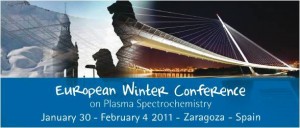(Carsten Engelhard) At the European Winter Conference Ryszard Lobinski (Laboratory of Analytical Bioinorganic and Environmental Chemistry, University of Pau, France) hosted a round table discussion on the current status and future of plasma-based analytical instrumentation. Participants from instrument manufactures included Dirk Ardelt (Spectro Analytical Instruments), Kaveh Kahen (Perkin Elmer), Paul Neal (Thermo Fisher Scientific), Andrew Ryan (Bruker), and Steven Wilbur (Agilent Technologies).
Four major topics were covered: a) current challenges in plasma source instrumentation, b) how to choose a plasma source spectrometer, c) plasma source spectrometry and society: new markets and applications, and last but not least, d) teaching and training in ICP spectroscopy.
During an enjoyable one-hour discussion, it was stated that plasma-based analytical instrumentation has come a long way since its first introduction, but that there is still a lot of room for improvement. In the future, it will presumably become more important to improve the absolute sensitivity, to reduce the required sample size, and to detect major constituents next to ultra trace elements with high precision. Moreover, environmental considerations and consumer needs might require the reduction of carbon footprint, and the use of low gas flow or miniaturized plasma-based analytical instrumentation.
It is clear that an interesting future lies ahead of plasma-based analytical instrumentation. The ideal analytical instrument that provides us with both atomic and molecular information with high precision and high sensitivity is still a vision. However, instrument manufactures as well as university researches are continuously working on the improvement of existing and the development of new instrumentation. There is still a lot to be done. Lets get started!











